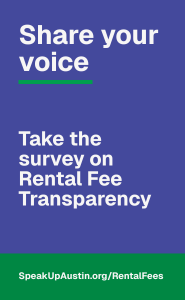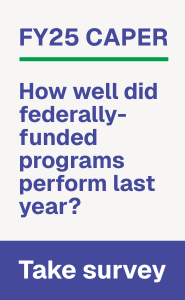About Project Connect: Community Initiated Solutions
The Austin Housing Finance Corporation (AHFC) and the City of Austin are investing in innovative ways to address and keep Austin communities together. Community Initiated Solutions empower organizations near the problem to reduce residential displacement and create economic mobility opportunities for their most vulnerable communities along Project Connect corridors. Due to affordability concerns for communities near Project Connect lines, $29 million of anti-displacement funding has been awarded to help prevent displacement.
Cancellation Notice
The Austin Housing Finance Corporation (AHFC) has officially canceled the Notice of Funding Availability (NOFA), issued on April 8, 2025. AHFC is currently pausing to conduct a comprehensive review of existing contracts, including their scopes of work, deliverables, and return on investment (ROI). This evaluation will help determine whether resources need to be realigned or reallocated to better support organizational goals.
NOFA Addendums and Clarifications
Project Connect CIS NOFA Addendum 1
Project Connect CIS NOFA Clarification 1
Project Connect CIS NOFA Addendum 2
Project Connect Community Initiated Solutions Inquiry Form
Austin residents at risk of displacement along the Project Connect lines can apply for housing assistance resources to help prevent displacement and keep communities together.
Resident Eligibility
Step 1 - Check your Eligibility
- Check your address here to see if you qualify! Note: Geographic eligibility includes: Living within 1 mile of Project Connect lines or stations in an area of Active, Vulnerable, or Chronic Displacement.
- Income Eligibility: 80% of Area Median Income
Step 2 - Fill out the Project Connect Community Initiated Solutions Inquiry Form
Community Initiated Solutions Organizations
In Years 1-2 of Project Connect Anti-Displacement funding, $18 million was allocated to 13 Community Initiated Solutions (CIS) organizations focusing on the needs of vulnerable neighborhoods.
For Years 3-5, an additional $10.9 million in anti-displacement funding was allocated to eight of the existing CIS organizations.
| Organization | Project Focus | Years 1-2 Awards | Years 3-5 Awards |
|---|---|---|---|
| Austin Cooperative Business Foundation Asociación de Residentes | The Asociación de Residentes North Lamar (ARNL) is a Manufactured Housing Community owned by residents as a cooperative. This program will assist with a property tax abatement strategy. | $516,206 | Did not apply for additional funding |
| Austin Tenants Council (A project of Texas Rio Grande Legal Aid - TRLA) | The anti-displacement funding will increase tenant stabilization along the Project Connect corridor by informing tenants of their rights through mediation, advocacy, and education. | $997,310 | $2,000,000 |
| Austin Voices for Education and Youth | The North Austin/Rundberg Community Stabilization Project will provide rent assistance for short-term stabilization, social work case management to increase resource access and workforce education, community building, advocacy, and tenant rights education to increase long-term housing stability. | $1,268,000 | $500,000 |
| Business & Community Lenders | The Austin CLT Accelerator will grow and scale the capacity of a cohort of nonprofits to increase community land trust availability, establishing long-term affordable homeownership opportunities along Project Connect transit lines to help households stabilize their finances and avoid displacement. | $2,000,000 | Did not apply for additional funding |
| Communities in School of Central Texas | The Student and Family Assistance (SAFA) program provides financial support to address housing insecurity, helping to stabilize students' home lives and prevent displacement. The program will integrate rental assistance into existing financial support processes and connect students and their families to financial wellness resources and events. | $1,500,000 | $2,000,000 |
| Del Valle Community Coalition | The Homeowner Resilience Program will support Southeast Austin homeowners at risk of displacement by providing community strategies and investment to preserve and build wealth responsive to homeowner needs via counseling, advocacy capacity-building, financial assistance, and educational Homeowner Resilience events. | $1,100,000 | $1,225,000 |
| El Buen Samaritano | The "We Belong Here" program will assist tenants with rent and utilities and provide economic mobility and opportunity through collaborations that provide access to early childhood, youth academic advancement, adult education, and workforce development. | $2,000,000 | $1,000,000 |
| Goodwill Industries of Central Texas | The Connections to Work program will support economic mobility within impacted areas through workforce programs providing job training and occupational skills training credentials for living-wage positions, financial capability services, and direct rent/mortgage and utility relief for eligible participants. | $2,000,000 | $1,725,000 |
| Interfaith Action of Central Texas (iACT) | The Financial Education and Literacy Program will provide financial education to vulnerable children, grades 6-12, and their families to help prepare them for a financially secure future. | $256,650 | $975,000 |
| Mama Sana Vibrant Woman | This program supports emergency rental assistance/eviction prevention grants to households who receive pregnancy, birthing, and/or postpartum services from MSVW and/or any member of Austin's Maternal Health Equity Collaborative (MHEC). | $1,537,835 | Did not apply for additional funding |
| Meals on Wheels Central Texas | The Client Assistance Program will provide case management and financial assistance (including rent, utilities, mortgage, financial education, and other housing expenses) to Meals on Wheels Central Texas (MOWCTX) clients who are most at-risk of displacement. | $900,000 | $1,475,000 |
| Life Anew Restorative Justice Inc. | The Anti-Displacement Property Ownership program will educate eligible homeowners on land ownership, estate planning, Zero Energy, Condo Regimes, and financial literacy. | $2,000,000 | Did not apply for additional funding |
| Workers Defense Project & Building And Strengthening Tenant Action | This tenant stabilization program builds tenant resiliency in Project Connect corridors by engaging renters in building infrastructure to combat displacement events. | $2,000,000 | Did not apply for additional funding |
Past Funding Priorities
- 2022
-
The funding round for 2022 included up to $20 million for nonprofit organizations and partnerships that prioritize:
Renter/tenant stabilization: Investments may include tenant legal services and representation, emergency rental assistance, education on fair housing laws and tenant rights, and other programs, services, and investments that prevent displacement by stabilizing tenants.
Expansion and preservation of homeownership opportunities: Investments may include down payment and closing cost assistance programs, mortgage assistance, foreclosure prevention assistance, HUD-approved housing counseling, home rehabilitation and repair loans, existing community land trusts and housing cooperatives, and other programs, services, and investments that prevent displacement by expanding and preserving homeownership opportunities.
Other anti-displacement strategies: Investments that support economic mobility opportunities within the impacted area of Project Connect and help prepare the affected communities survive and even thrive in crisis. Asset building strategies that facilitate access to capital, estate planning, financial capability (education and literacy), leveraging affordable housing to create good paying jobs and skill building labs, as well as other innovative models that preserve and expand the community’s assets, and strengthen it through economic mobility opportunities may be considered.
Complete requirements, eligibility, and funding criteria are available in Notice of Funding Availability (PDF) —updated May 24, 2022—for Community Initiated Solutions.
Organization Application Review Process
The application review process consisted of three steps:
- Completeness Check: Applications were pre-screened by staff to ensure minimum requirements were met.
- Community Evaluation Panel: Applications were reviewed by a community evaluation panel composed of practitioners, academics, and stakeholders from communities most impacted by displacement. The panels reviewed and scored proposals using evaluation criteria informed by the Nothing About Us Without Us report and tool. The review panels provided a list of scored, ranked proposals to a working group of the Community Advisory Committee.
- Review Panel: A working group of the Community Advisory Committee will consider balances between funding categories and recommend proposals for funding to Austin Housing Finance Corporation Board for final approval.
Frequently Asked Questions (FAQs)
The following clarification document includes a summary of questions from the public received by the Austin Housing Finance Corporation as of May 17, 2022, with relevant responses.
- 2025
-
The funding round for 2025 included up to $5 million for nonprofit organizations and partnerships that prioritize:

Investments that support economic mobility opportunities within the impacted area of Project Connect and help prepare the affected communities survive and even thrive in crisis. Asset building strategies that facilitate access to capital, estate planning, financial capability (education and literacy), leveraging affordable housing to create good paying jobs and skill building labs, as well as other innovative models that preserve and expand the community’s assets, and strengthen it through economic mobility opportunities may be considered.
All investments must be focused within 1 mile of Project Connect stations (see map) in communities with vulnerable, active, and chronic displacement risk.
Complete requirements, eligibility, and funding criteria are available in Notice of Funding Availability (PDF).
Funding Availability Timeline
Notice of Funding Availability (NOFA) Released April 8, 2025 Application Deadline June 13, 2025 at 5 PM CST Award Recommendation On or before January 1, 2026 All communications concerning this solicitation shall be directed to the POCs named below (any communication other than with the following POCs will be considered unofficial and non-binding):
Ursula Henderson
- Ursula.henderson@austintexas.gov / 512-974-3126
Sarah Ramos
- Sarah.ramos@austintexas.gov / 512-974-2554
NOFA Addendums and Clarifications
Project Connect CIS NOFA Addendum 1
Project Connect CIS NOFA Clarification 1



